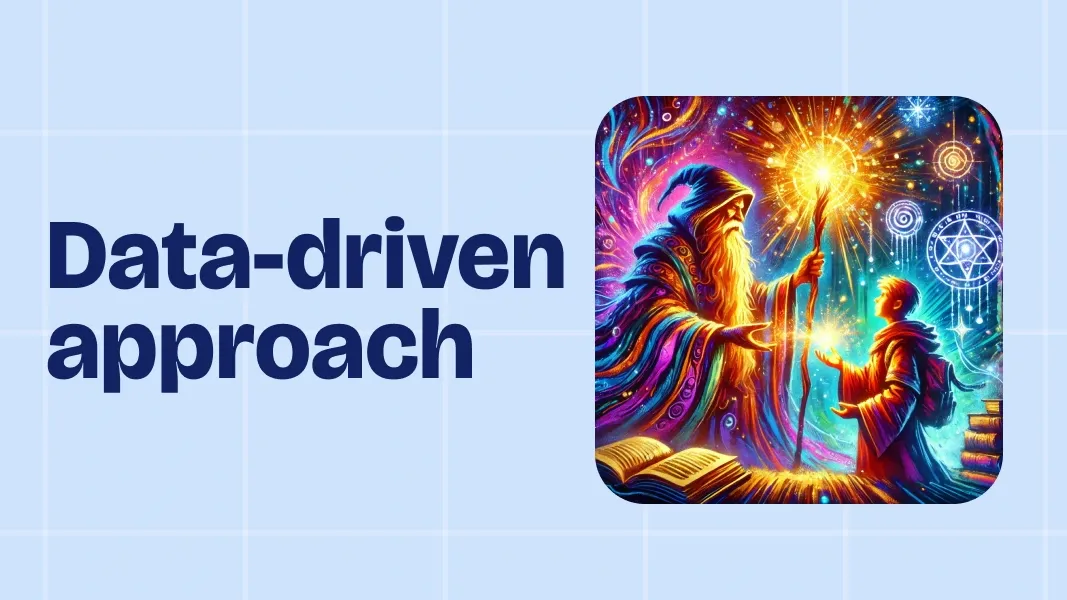Data-driven game development: a guide for emerging studios
January 27, 2025
In the fast-paced world of game development, success isn’t just about great ideas—it’s about smart, data-driven decisions. If you’re running a small studio or celebrating your first success, this guide is for you. Let’s dive into how you can use data to propel your game from concept to hit.The old way vs. the smart way
The intuition trap
Many studios fall into the “intuition trap.” They rely solely on team experience or try to replicate others’ success. While experience is valuable, it’s not enough in today’s competitive market. This approach often leads to:
- Ballooning development budgets
- Endless cycles of “just one more feature”
- Delayed decisions and potential project closure
The data-driven revolution
Smart studios are embracing a data-driven, iterative approach. This method allows for:
- Timely, informed decisions
- Efficient progression from prototype to public release
- Maximized chances of success and profitability
Let’s break down each stage of development and the crucial metrics you should track.
Stage 1: Prototype
Goal: Validate your core concept quickly and cheaply.
Key metrics:
- Cost Per Install (CPI)
- Average Session Length
- Number of Sessions per User
- Day 1 Retention (D1)
Action items:
- Create a bare-bones version of your core gameplay loop
- Set up basic analytics (e.g., Magify)
- Run small-scale ads on Facebook to attract testers
- Aim for a D1 retention of at least 30%
Pro tip: Don’t obsess over polish at this stage. Focus on whether players understand and enjoy your core mechanic.
Stage 2: Minimum viable product (MVP)
Goal: Expand your game’s features and test monetization.
Key metrics:
- CPI and Cost Per Acquisition (CPA)
- Retention (D1, D2, D3, D7)
- Average Session Length
- Number of Sessions per User
- Percentage of Paying Users
Action items:
- Implement basic monetization (e.g., in-app purchases)
- Expand ad sources (try Unity Ads and AppLovin)
- Set up more comprehensive analytics (e.g., Magify)
- Start A/B testing core features
- Polish art and refine visuals to make the game more appealing.
- Content generation like new levels, characters, or items to keep players engaged.
Pro tip: Aim for a D7 retention of at least 10%. If you’re below this, focus on improving your core loop before adding more features.
Stage 3: Soft launch
Goal: Optimize your game for profitability.
Key metrics:
- Return on Ad Spend (ROAS) for D1, D7, D30
- Retention (D1, D7, D14, D30)
- Average Revenue Per User (ARPU) over time
- Customer Acquisition Cost (CAC)
Action items:
- Launch in a test market (e.g., Canada or Netherlands)
- Implement full monetization strategy
- Set up end-to-end analytics
- Start using a Business Intelligence (BI) tool for deeper insights
pro tip: Your D1 to D7 retention drop-off should be less than 70%. If it’s higher, you may have early-game progression issues.
Stage 4: Public release
Goal: Scale your user base while maintaining profitability.
Key metrics:
- Long-term ROAS (up to D180)
- Long-term retention (up to D180)
- Lifetime Value (LTV) predictions
- User acquisition channel performance
Action items:
- Expand to more ad networks
- Implement LiveOps strategy (events, offers, etc.)
- Continually A/B test new features and content
- Monitor and act on user feedback
Pro tip: Aim for a break-even point on user acquisition within 60 days. This allows for sustainable growth.
Essential tools for success
- Analytics suite: Magify, gameanalytics, amplitude
- A/B Testing tool: Magify, FireBase
- Attribution tool: Adjust or AppsFlyer, Singular, Tanjin and more
- BI for gamedev: Magify
The importance of benchmarks and A/B testing
At every stage of development, it’s crucial to:
- Rely on genre benchmarks: Always analyze competitors’ metrics to understand where you stand in the market.
- A/B test everything: All changes in meta- and core gameplay should go through rigorous A/B testing. This ensures data objectivity and prevents decisions based on hunches.
- Understand acceptable deviations: In early stages, a 10-20% deviation in metrics from benchmarks is acceptable due to imperfections in art, gameplay, and code. As your game progresses, aim to narrow this margin.
Marketing and data accuracy
- Focus on creatives and traffic acquisition: These aspects are critical. Mistakes here can lead to distorted metrics and increased burn rates.
- Combat fraud early: Set up fraud detection from day one. Small traffic volumes in early stages make your product vulnerable to fraudulent schemes, which can severely skew your data.
The power of end-to-end analytics
Starting from the MVP stage, implement end-to-end analytics to:
- Understand the quality of acquired traffic
- Differentiate user behavior from various sources
- Prevent metric merging, which can obscure important insights
Speeding up data interpretation
For fast, effective decision-making, invest in a Business Intelligence (BI) system that offers:
- Mobile Measurement Partner (MMP) data integration
- Comprehensive revenue and user behavior analysis
- Automated ROAS forecasting
Operational support and liveOps
- Personalization is key: At the MVP+ stage, focus on personalizing game balance and monetization. This can provide a significant 40%+ boost in LTV and open up new marketing opportunities.
- Embrace LiveOps: After public release, shift focus to regular updates, community engagement, and continuous game polishing.
- Monitor continuously: Keep a close eye on traffic profitability and the impact of product changes on user LTV through ongoing A/B tests.
Final words of wisdom
- Data is your compass: Let it guide your decisions, but don’t forget the importance of creativity and intuition in game design.
- Stay agile: Be prepared to pivot based on what your data tells you.
- Focus on user experience: Remember, behind every data point is a real player. Use your data to create better experiences for them.
- Invest in your tools: Good analytics and BI tools pay for themselves many times over.
- Never stop learning: The mobile game industry evolves rapidly. Stay updated with the latest trends and technologies.
Remember, in the world of game development, data is your most powerful ally. Use it wisely, and you’ll navigate your way to success. Happy developing!



